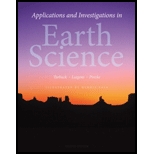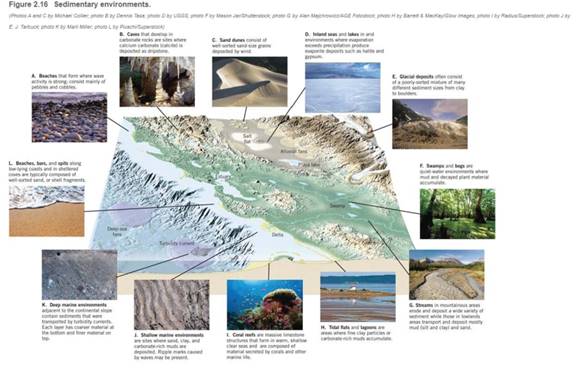
Applications and Investigations in Earth Science (8th Edition)
8th Edition
ISBN: 9780321934529
Author: Edward J. Tarbuck, Frederick K. Lutgens, Dennis G. Tasa, Kenneth G. Pinzke
Publisher: PEARSON
expand_more
expand_more
format_list_bulleted
Textbook Question
Chapter 2.7, Problem 1A
Use Figure 2.16 to identify the environment(s) (A- L) where the sediment for the following sedimentary rocks could have been deposited.
Rock gypsum
Conglomerate
Sandstone
Shale
Bituminous coal
Travertine

Expert Solution & Answer
Learn your wayIncludes step-by-step video

schedule03:40
Students have asked these similar questions
I need help on Part C
I need help with part a and b
In fig A13.2.3, what are the gradient and sinuosity of Passage Creek from G and G? Refer to figs. 12.3 and 12.4 for help measuring gradient and sinuosity. Show your calculations. You will graph it later in the activity.
Gradient: ______ ft/mi
Sinuosity:
Chapter 2 Solutions
Applications and Investigations in Earth Science (8th Edition)
Ch. 2.1 - Label the rock cycle diagram In Figure 2.3 Figure...Ch. 2.1 - What is magma? How does magma differ from lava?Ch. 2.1 - The terms intrusive and extrusive are used to...Ch. 2.1 - In your own words, write a definition of rock...Ch. 2.1 - Name the process by which sediment is transformed...Ch. 2.1 - What is the most characteristic feature of...Ch. 2.1 - What type of rock is generated when rocks that...Ch. 2.1 - When determining rock composition, describe the...Ch. 2.2 - Which samples A- H exhibits porphyritic texture?Ch. 2.2 - For the samples you listed in Question 1, whal...
Ch. 2.2 - Which samples in Figure 2.9 exhibits...Ch. 2.2 - Complete the description of the environment which...Ch. 2.2 - Which samples in Figure 2.9 exhibits fine-grained...Ch. 2.2 - Complete the description of the environment which...Ch. 2.2 - Which samples in Figure 2.9 exhibits vesicular...Ch. 2.2 - Which samples in Figure 2.9 exhibits glassy...Ch. 2.2 - Although Samples A and C In Figure 2.9 appear...Ch. 2.3 - Prob. 1ACh. 2.3 - Prob. 2ACh. 2.3 - Prob. 3ACh. 2.4 - Prob. 1ACh. 2.5 - Carefully examine the common sedimentary rocks...Ch. 2.5 - Carefully examine the common sedimentary rocks...Ch. 2.5 - Carefully examine the common sedimentary rocks...Ch. 2.5 - Carefully examine the common sedimentary rocks...Ch. 2.5 - Carefully examine the common sedimentary rocks...Ch. 2.5 - Carefully examine the common sedimentary rocks...Ch. 2.5 - Carefully examine the common sedimentary rocks...Ch. 2.5 - Carefully examine the common sedimentary rocks...Ch. 2.5 - Carefully examine the common sedimentary rocks...Ch. 2.5 - What mineral does Sample D contain that gives it a...Ch. 2.6 - Prob. 1ACh. 2.7 - Use Figure 2.16 to identify the environments A- L...Ch. 2.7 - Briefly describe the environment that is...Ch. 2.7 - The rocks in Zion National Park, Utah, consist of...Ch. 2 - The rock samples you encountered while completing...Ch. 2 - Match each of the metamorphic rocks listed below...Ch. 2 - Match each term or characteristics with the...Ch. 2 - Identify the folliated metamorphic rocks shown In...Ch. 2 - Identify each of the rocks shown in Figure 2.26...
Additional Science Textbook Solutions
Find more solutions based on key concepts
What is the anatomical position? Why is it important that you learn this position?
Anatomy & Physiology (6th Edition)
Modified True/False 9. A giant bacterium that is large enough to be seen without a microscope is Selenomonas.
Microbiology with Diseases by Body System (5th Edition)
Practice Exercise 2
Aspirin is composed of 60.0% carbon, 4.5% hydrogen, and 35.5% oxygen by mass, regardless o...
Chemistry: The Central Science (14th Edition)
Flask A contains yeast cells in glucose-minimal salts broth incubated at 30C with aeration. Flask B contains ye...
Microbiology: An Introduction
APPLY 1.2 Express the following quantities in scientific notation
using fundamental SI units of mass and lengt...
Chemistry (7th Edition)
56. Global Positioning System. Learn more about the global positioning system and its uses. Write a short repo...
The Cosmic Perspective (8th Edition)
Knowledge Booster
Similar questions
- please do these for me and explain in detailarrow_forwardActivity 12.3: Wave Refraction Pgs 202-203Figure 12.2 is a map view of a headland along a coastline. The water depths are shown by blue contour lines. As you complete the following questions, assume that waves with a wavelength of 60 feet are approaching the shoreline from the bottom left of the figure. 1. At approximately what water depth-10, 20, 30, or 40 feet-will the approaching waves begin to touch bottom and slow down? (Hint: Recall that this occurs when the water depth is one-half the wavelength.) 2. Using the wave shown in Figure 12.2 as a starting point, sketch a series of lines to illustrate the wave refraction that will occur as the wave approaches the shore by following these steps:Step 1: Mark the position on the 30-foot contour line where the wave front will first touch bottom.Step 2: Knowing that the section of the wave that touches bottom will slow down first, sketch the shape of the wave front when it reaches the 20-foot contour line.Step 3: Using the same…arrow_forwardN Depth of water contour Advancing wave crest Beach HEADLAND -10- -20- -30' Land -40'- 50- 0 Beach Scale 200 feetarrow_forward
- Activity 12.5A: Identifying Shoreline Features Pgs 206-2081. Use the descriptions of shoreline features provided above to label the structures in Figures 12.5 and 12.6. The same feature may appear more than once. 2. Next to each of the features listed below, indicate whether it is the result of erosional or depositional processes.Sea stack:Wave-cut cliff:Spit:Barrier island:Baymouth bar:Marine terrace:arrow_forward3. Label a marine terrace, a wave-cut cliff, and a wave-cut platform in Figure 12.7. 4. Label a baymouth bar and a spit in Figure 12.8.arrow_forwardMy question: How does unequal school resources and fundings affect job opportunities for underprivileged groups? Can you go into 2. Gather facts related to your topic by using recommended Dallas College Library databases, like PubMed and Psychology Gale Academic OneFile. select important facts and statistics that will help you to answer your research question. Articles you select must be published within 5 years (2019-2024). Can you find as much articles that you can that answer my question.arrow_forward
arrow_back_ios
SEE MORE QUESTIONS
arrow_forward_ios
Recommended textbooks for you
 Applications and Investigations in Earth Science ...Earth ScienceISBN:9780134746241Author:Edward J. Tarbuck, Frederick K. Lutgens, Dennis G. TasaPublisher:PEARSON
Applications and Investigations in Earth Science ...Earth ScienceISBN:9780134746241Author:Edward J. Tarbuck, Frederick K. Lutgens, Dennis G. TasaPublisher:PEARSON Exercises for Weather & Climate (9th Edition)Earth ScienceISBN:9780134041360Author:Greg CarbonePublisher:PEARSON
Exercises for Weather & Climate (9th Edition)Earth ScienceISBN:9780134041360Author:Greg CarbonePublisher:PEARSON Environmental ScienceEarth ScienceISBN:9781260153125Author:William P Cunningham Prof., Mary Ann Cunningham ProfessorPublisher:McGraw-Hill Education
Environmental ScienceEarth ScienceISBN:9781260153125Author:William P Cunningham Prof., Mary Ann Cunningham ProfessorPublisher:McGraw-Hill Education Earth Science (15th Edition)Earth ScienceISBN:9780134543536Author:Edward J. Tarbuck, Frederick K. Lutgens, Dennis G. TasaPublisher:PEARSON
Earth Science (15th Edition)Earth ScienceISBN:9780134543536Author:Edward J. Tarbuck, Frederick K. Lutgens, Dennis G. TasaPublisher:PEARSON Environmental Science (MindTap Course List)Earth ScienceISBN:9781337569613Author:G. Tyler Miller, Scott SpoolmanPublisher:Cengage Learning
Environmental Science (MindTap Course List)Earth ScienceISBN:9781337569613Author:G. Tyler Miller, Scott SpoolmanPublisher:Cengage Learning Physical GeologyEarth ScienceISBN:9781259916823Author:Plummer, Charles C., CARLSON, Diane H., Hammersley, LisaPublisher:Mcgraw-hill Education,
Physical GeologyEarth ScienceISBN:9781259916823Author:Plummer, Charles C., CARLSON, Diane H., Hammersley, LisaPublisher:Mcgraw-hill Education,

Applications and Investigations in Earth Science ...
Earth Science
ISBN:9780134746241
Author:Edward J. Tarbuck, Frederick K. Lutgens, Dennis G. Tasa
Publisher:PEARSON

Exercises for Weather & Climate (9th Edition)
Earth Science
ISBN:9780134041360
Author:Greg Carbone
Publisher:PEARSON

Environmental Science
Earth Science
ISBN:9781260153125
Author:William P Cunningham Prof., Mary Ann Cunningham Professor
Publisher:McGraw-Hill Education

Earth Science (15th Edition)
Earth Science
ISBN:9780134543536
Author:Edward J. Tarbuck, Frederick K. Lutgens, Dennis G. Tasa
Publisher:PEARSON

Environmental Science (MindTap Course List)
Earth Science
ISBN:9781337569613
Author:G. Tyler Miller, Scott Spoolman
Publisher:Cengage Learning

Physical Geology
Earth Science
ISBN:9781259916823
Author:Plummer, Charles C., CARLSON, Diane H., Hammersley, Lisa
Publisher:Mcgraw-hill Education,